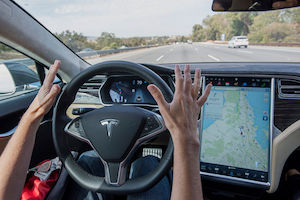The National Transportation Safety Board said Wednesday that a combination of factors that included driver inattention, the design of Tesla’s advanced driver assistance system Autopilot and an over-reliance on the feature caused the January 2018 crash of a Model S into a parked fire truck on a highway in Southern California.
The NTSB filed its briefing on the probable cause of the crash a day after issuing a preliminary brief that provided important details about the incident, including that the Model S was in Autopilot mode when it crashed into the fire truck.
The crash, involving a 2014 Tesla Model S, occurred January 22, 2018 in Culver City, Calif. The Tesla had Autopilot engaged for nearly 14 minutes when it struck a fire truck that was parked on Interstate 405. The driver was not injured in the crash and the fire truck was unoccupied.
While the Tesla Model S owner’s manual contains numerous warnings about the limitations of these features and the need for drivers to keep their hands on the wheel, the driver was not paying attention, the NTSB said. More importantly, the Tesla’s Autopilot design permitted the driver to disengage from the driving task, the NTSB concluded.
Autopilot was engaged in the final 13 minutes and 48 seconds of the trip and yet, the system detected driver-applied steering wheel torque for only 51 seconds of that time, the NTSB said. It should be noted that the vehicle involved in the crash was a “Hardware 1” version. A hardware 2 version of the Model S went into production in 2016 and includes a more robust suite of sensors.
Tesla responded to the report noting that owners have driven billions of miles with Autopilot engaged and that data from its quarterly Vehicle Safety Report indicates that drivers using Autopilot remain safer than those operating without assistance.
Since the crash, Tesla has made updates to its Autopilot system, including adjusting the time intervals between hands-on warnings and the conditions under which they’re activated, a spokesperson said in a statement.
Autopilot includes two important features, Autosteer and Traffic-Aware Cruise Control. Autosteer is a lane-keeping assist system that can only be engaged after Traffic-Aware Cruise Control is activated. The Traffic-Aware Cruise Control is an adaptive cruise control system that modifies speed based on information from the camera and radar sensors.
Details of the crash
According to NTSB, the Model S had Autopilot engaged and was in the HOV lane following another car. In the 15 seconds prior to the crash the system detected and followed two different lead vehicles. Data shows that 3 to 4 seconds before the crash, the lead vehicle changed lanes to the right, the NTSB report says. When the Traffic-Aware Cruise Control no longer detected the lead vehicle, the system accelerated the Tesla from about 21 mph toward the preset cruise speed of 80 mph, which had been set by the driver about 5 minutes before the crash, the report says.
The “Autopilot” system detected a stationary object in the Tesla’s path about 0.49 seconds before the crash and the forward collision warning activated, displaying a visual warning and sounding an auditory warning. By the moment of impact, the Tesla had accelerated to 30.9 mph.
